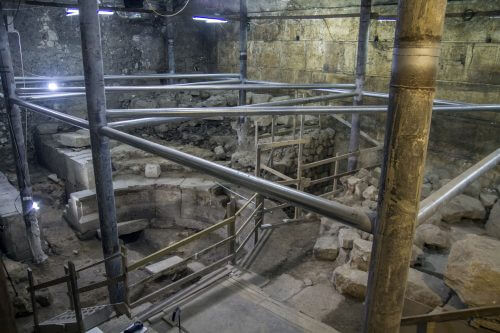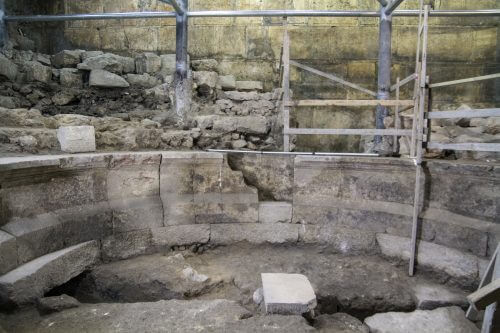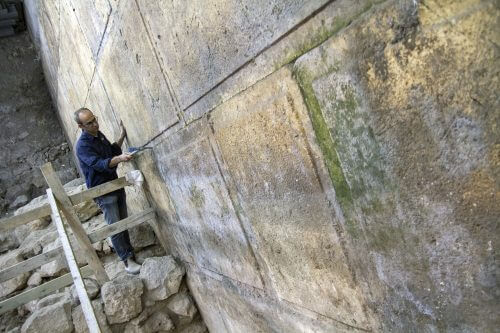In the excavations of the Antiquities Authority with the participation of volunteers, large parts of the courses of the Western Wall that have not been visible for 1700 years are revealed * For the first time, an ancient Roman theater building was revealed in Jerusalem

Eight courses from the Western Wall, which were buried under a layer of dirt about 8 meters thick, were recently uncovered by the Antiquities Authority excavations in the tunnels of the Western Wall in Jerusalem. These stone courses, which have been completely preserved, are built of huge stones and excel in the quality of their construction. But that was not enough: after removing the layer of dirt, the archaeologists were surprised to discover that it actually covered the remains of a unique, theater-like structure.
The dramatic exposure confirms the historical writings in which there are descriptions of a theater located near the Temple Mount.
The exciting discoveries will be presented to the public for the first time at the conference "Innovations in the Archeology of Jerusalem and its Surroundings" which will be held this week in Jerusalem to mark the 50th anniversary of the unification of the city.
At a press conference held on Monday under the Wilson Arch in the tunnels of the Western Wall, with the participation of Rabbi of the Western Wall Rabbi Shmuel Rabinowitz, Director of the Israel Antiquities Authority Hasson, CEO of the Western Heritage Fund Mordechai (Soli) Eliav, Archaeologist of the Jerusalem Region at the Antiquities Authority Dr. Yuval Baruch and the managers of the excavation were presented For the first time, the layers of the Kotel were exposed and the magnificent remains of the theater building, which seems to have been invested in its construction and contained about 200 seats.
Since the beginning of the archaeological research in Jerusalem 150 years ago, researchers have been looking for the public buildings mentioned in the historical sources. Particularly prominent are the references to theaters, or theater-like buildings. These references are found in the written sources of the days of the Second Temple (for example, Josephus), and in the sources of the period after the destruction of the Second Temple, when Jerusalem became a Roman colony called Ilia Capitolina. The location of these buildings had many theoretical suggestions, but they had no archaeological basis. That is, until the latest revelations.
Wilson's Arch is actually the only intact structure left from the Temple Mount complex of the Second Temple days when it is visible to the eye. The arch, built of huge stones, is the last in a series of stone arches that made up a huge bridge, which led to the Temple Mount from the west. The arch hangs at a great height above the foundations of the Western Wall, and it allowed, among other things, the passage of people into the Temple Mount complex and the temple. A large aqueduct even passed over the arch.

According to the archaeologists who managed the dig, Dr. Joe Uziel, Tahila Lieberman and Dr. Avi Solomon, "This is a research sensation. The discovery was a real surprise. When we approached the excavation in order to date the Wilson Arch, we did not imagine that it would open a window to the mystery of the lost theater of Jerusalem. As in many cases in archaeology, there is an expectation to uncover a certain thing, but at the end of the process, other surprising and thought-provoking findings are revealed. There is no doubt that the exposure of the courses of the Western Wall and the components of the Wilson Arch are
Exciting discoveries that contribute to the investigation of the city of Jerusalem and its past history, but the discovery of the theater-like structure is a real drama in research." The site's researchers point out that "although it is a small building compared to the known Roman theaters (such as Caesarea, Beit Shan and Beit Guberin), this fact - in addition to its being under a covered space - in this case under the Wilson Arch, leads us to the conclusion that it is a theater-like structure of the type known In the Roman world called "Odeon". For the most part such buildings were used for acoustic shows. Alternatively, it can be suggested that it is a building known as the "Bolterion" - that is, the seat and meeting place of the city council, in this case of the "Ilia Capitolina" council - Roman Jerusalem.
It is interesting to note that according to the archaeologists, the theater was never used. A number of finds on the site hint at this - among other things, staircases whose cutting was not completed. It is clear that a lot of effort was put into building the structure, but surprisingly it was abandoned before it was put to use. The reasons for this are unknown, but they may be related to a significant historical event - perhaps the Bar Kochba rebellion; The structure may have begun to be built, but when the rebellion broke out, it was abandoned. Additional evidence of the non-completion of buildings during this period was previously uncovered in the excavations of the eastern Cardo in the Western Wall plaza.
In the excavation of Keshet Wilson, many finds are discovered, some of them unique, including thousands of pottery, coins, architectural items, sculpture, and more. In the excavation, he made regular use of advanced research methods and different fields of research that make it possible to identify under the microscope lens remains that the eye cannot see, through which the researchers can reach insights with a higher level of accuracy than was done in the past. As such, the archaeological research at the Wilson request constitutes a pioneering and ground-breaking microarchaeological study.
According to the Rabbi of the Western Wall and the Holy Places, Rabbi Shmuel Rabinowitz: "Time after time, the amazing archaeological findings come and allow our contemporaries to touch the ancient history of our people and the heritage of Judaism with its deep connection to Jerusalem." Every find like this excites me anew in great bones. We still have a long digging job ahead of us and I am sure that the deeper we dig, the more we will reach earlier periods and witness the deep attachment of the Jewish people to the Land of Israel and Jerusalem.'

According to Israel Hasson, director of the Antiquities Authority: "The Antiquities Authority is working to promote a national project to uncover ancient Jerusalem. This plan was approved in principle at the cabinet meeting on the occasion of the 50th anniversary of the unification of Jerusalem. The fascinating findings from the Keshet Wilson excavations reinforce the importance of expanding the archaeological excavations in this important area, and I hope that the findings will help us advance the overall plan, so that we all get to experience ancient Jerusalem in its glory. We will be happy to complete the excavation in the Wilson Arch and the excavation of ancient Jerusalem together with the XNUMXth grade students in Israel, as part of the "I have a stone from the stones of Jerusalem" project.
According to Dr. Yuval Baruch, an archaeologist for the Jerusalem region at the Antiquities Authority, "the exposure under the Wilson Arch was born as a joint initiative of the Western Wall Heritage Foundation and the Antiquities Authority with the intention of creating a new tourist route in the tunnels of the Western Wall, which should enable a new experience of visiting the site and allow the visitor to be exposed to the spectacular archaeological discoveries that were uncovered there In recent years. These remains include, among others, the remains of a magnificent building from the Second Temple period, mikveh complexes, and the highlight now are the finds that were uncovered under the Wilson Arch. After the end of the excavations at the site, the Antiquities Authority, together with the Western Wall Heritage Foundation, will begin preparing the plans for preserving the findings and presenting them to the public visiting the site."
According to the CEO of the Western Wall Heritage Foundation, Mordechai (Soli) Eliav: "Indeed, this is one of the most important discoveries uncovered in my thirty years at the Western Wall Heritage Foundation. A discovery that joins the series of other findings uncovered in the area of the Western Wall Plaza, findings that together create a living historical mosaic that reinforces the end of generations for Jerusalem and the Western Wall. There is no doubt that the scientific wealth inherent in this region will not be without a price, it is added to another line of guests from former empires who have been here over the years, compared to the Jewish people who stuck here about three thousand years ago and have been here ever since. The uncovering of these stones of the Western Wall for the first time after about 1,700 years in its lower layers is very exciting. The Wall, a remnant of our temple and the multitude of finds around it, which teach about the thousands of years of our presence here - are a magnet for hundreds of thousands more who visit the site as we saw only recently during the terrible days and the Sukkot holiday."
